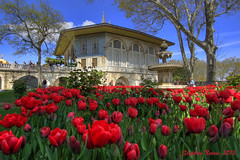Stephan Neven ha aggiunto una foto al pool:
The Topkapı Palace is a large palace in Istanbul, Turkey, that was the primary residence of the Ottoman Sultans for approximately 400 years (1465-1856) of their 624-year reign.
As well as a royal residence, the palace was a setting for state occasions and royal entertainments. It is now a major tourist attraction and contains important holy relics of the Muslim world, including Muhammed’s cloak and sword. The Topkapı Palace is among the monuments contained within the "Historic Areas of Istanbul", which became a UNESCO World Heritage Site in 1985, and is described under UNESCO’s criterion iv as "the best example[s] of ensembles of palaces […] of the Ottoman period."<
The palace complex consists of four main courtyards and many smaller buildings. At its peak, the palace was home to as many as 4,000 people, and covered a large area with a long shoreline. It contained mosques, a hospital, bakeries, and a mint. Construction began in 1459, ordered by Sultan Mehmed II, the conqueror of Byzantine Constantinople. It was originally called the New Palace (Yeni Sarayı) to distinguish it from the previous residence. It received the name "Topkapı" (Cannon Gate) in the 19th century, after a (now lost) gate and shore pavilion. The complex was expanded over the centuries, with major renovations after the 1509 earthquake and the 1665 fire.
After the 17th century the Topkapı Palace gradually lost its importance as the sultans preferred to spend more time in their new palaces along the Bosporus. In 1856, Sultan Abdül Mecid I decided to move the court to the newly built Dolmabahçe Palace, the first European-style palace in the city. Some functions, such as the imperial treasury, the library, and the mint, were retained in the Topkapı Palace.
Following the end of the Ottoman Empire in 1921, Topkapı Palace was transformed by a government decree dated April 3, 1924 into a museum of the imperial era. The Topkapı Palace Museum is administered by the Ministry of Culture and Tourism. The palace complex has hundreds of rooms and chambers, but only the most important are accessible to the public today. The complex is guarded by officials of the ministry as well as armed guards of the Turkish military. The palace includes many fine examples of Ottoman architecture. It contains large collections of porcelain, robes, weapons, shields, armor, Ottoman miniatures, Islamic calligraphic manuscripts and murals, as well as a display of Ottoman treasures and jewelry.
The Fourth Courtyard (IV. Avlu), also known as the Imperial Sofa (Sofa-ı Hümâyûn), was more of an innermost private sanctuary of the sultan and his family, and consists of a number of pavilions, kiosks (köşk), gardens and terraces. It was originally a part of the Third Courtyard but recent scholars have identified it as more separate to better distinguish it.
All gardens of the Topkapı Palace are filled with tulips. Lovely to see for me, as a Dutchman. I always had the impression that tulips originated from Western Europe (and mostly from The Netherlands because we have become famous with it: the Keukenhof, flowers at the papal ‘Urbi et Orbi’ in Vatican City etc.), but I only just learned that an ambassador of Suleyman the Magnificent of the Ottoman Empire introduced the tulip in Germany. In hindsight, I understand why those gardens at the Topkapı Palace were filled with tulips. After the introduction in Germany ‘tulipmania’ spread to the rest of Europe, and the Dutch became famous with it. Or as Wikipedia says: "To this day, tulips are associated with the Netherlands, and the cultivated forms of the tulip are often called "Dutch tulips." In addition to the tulip industry and tulip festivals, the Netherlands has the world’s largest permanent display of tulips at Keukenhof, although the display is only open to the public seasonally."
